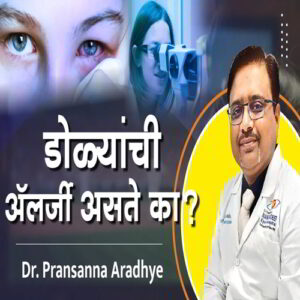The Ultimate Guide to Preventing and Managing Dry Eyes Effectively

In today’s world, issues like eye irritation, fatigue, burning, or stinging sensations are common. These symptoms are often caused by dry eye syndrome, a multifactorial condition in which the eyes cannot produce quality tears for proper lubrication.
Spending too much time on screens, exposure to pollution, and lack of sleep are a few culprits that cause dry eye. In this blog, we will discuss the dry eyes symptoms, causes and treatments. Stay with us to learn more.
Why Do Our Eyes Need Lubrication?
Similar to machines that work smoothly with oiling, the eyes require adequate lubrication for protection. Tears, the eyes’ natural lubricant, help the eyelids move (open & close) easily, clear out dust particles, and form a protective shield to ensure their safety.
The Three Aqueous Humor Layers
- Mucin Layer: Forms a protective barrier on the ocular surface and helps the tear film adhere to the eye.
- Aqueous Layer: The middle layer, comprising water, which keeps the eyes hydrated, clears out debris, and helps prevent infection.
- Lipid Layer: The outermost layer, which prevents evaporation of the aqueous layer.
Causes of Dry Eyes
When the aqueous layer fails to adequately supply moisture to the lipid layer dry eyes condition occurs. The Meibomian glands release oils that spread across the eye’s surface when blinking. If the glands face blockage or the eyes do not blink regularly, oil production decreases, and the aqueous layer dries out, resulting in a gritty sensation.
Symptoms of Dry Eyes
Dry eyes can mean other eye problems and cause a range of uncomfortable symptoms:
- Redness
- Itching or irritation
- Dull appearance
- Eye fatigue or strain
Persistent dry eye condition also makes chores like reading or prolonged screen work challenging. If you notice these symptoms, you should consult an eye specialist. At Nandadeep Eye Hospital, our ophthalmologists provide expert treatment for dry eyes, cataracts, and other eye conditions. Give us a call on 92 20001000 to speak with an eye expert.
Is There a Cure for Dry Eyes?
No, to this day there is no permanent cure for dry eyes. However, the right precautions and managing symptoms can reduce their severity. Here are some advised practices:
- A Good Night Sleep and Rest: Eight hours of sleep can reduce eye dryness and fatigue. For those in the tech business who work with screens, regular breaks can help keep the eyes lubricated.
- Limit Screen Time (SOT): Prolonged exposure to screen light hinders regular blinking, leading to lower oil production and drier eyes. However, by following the 20-20-20 rule can ease eye strain. This involves looking 20 feet away every 20 minutes for at least 20 seconds.
- Diet Change: Dietary changes can impact big. Rich in omega-3 foods, such as fish, help with the lipid layer’s oil production. Vegetarians can opt for almonds and walnuts to obtain these fatty acids.
- Stay Hydrated: A dehydrated body can also lead to dry eyes. Drinking plenty of water and eating water-rich green veggies can increase the hydration in the aqueous layer.
- Try Warm Compresses: A warm compress of a wet towel to closed eyes for five minutes can stimulate oil release from the Meibomian glands and reduce dryness.
- IPL Therapy: Intense Pulsed Light therapy is an effective option for prolonged dry eye conditions. IPL stimulates the Meibomian glands, enhancing tear quality and providing relief from dryness.
Final Remarks
Dry eyes are a common condition, but if left untreated, it can lead to chronic issues and more severe eye diseases. While there is no cure, early actions such as diet changes, simple home treatments, and, if necessary, professional eye care can provide relief and prevent worsening effects.
At Nandadeep Eye Hospital, we are dedicated to helping our patients achieve clearer vision. From minor eye care to complex surgeries, our team of ophthalmologists in India and eye surgeons welcome all eye issues to provide patients with optimal vision.
More Posts

Eye Allergies: Causes, Symptoms, and Treatments

Eye Care for Diabetic Retinopathy: Diagnosis & Treatment

शासकीय नोकरीसाठी डोळ्याची दृष्टी नियमावली







